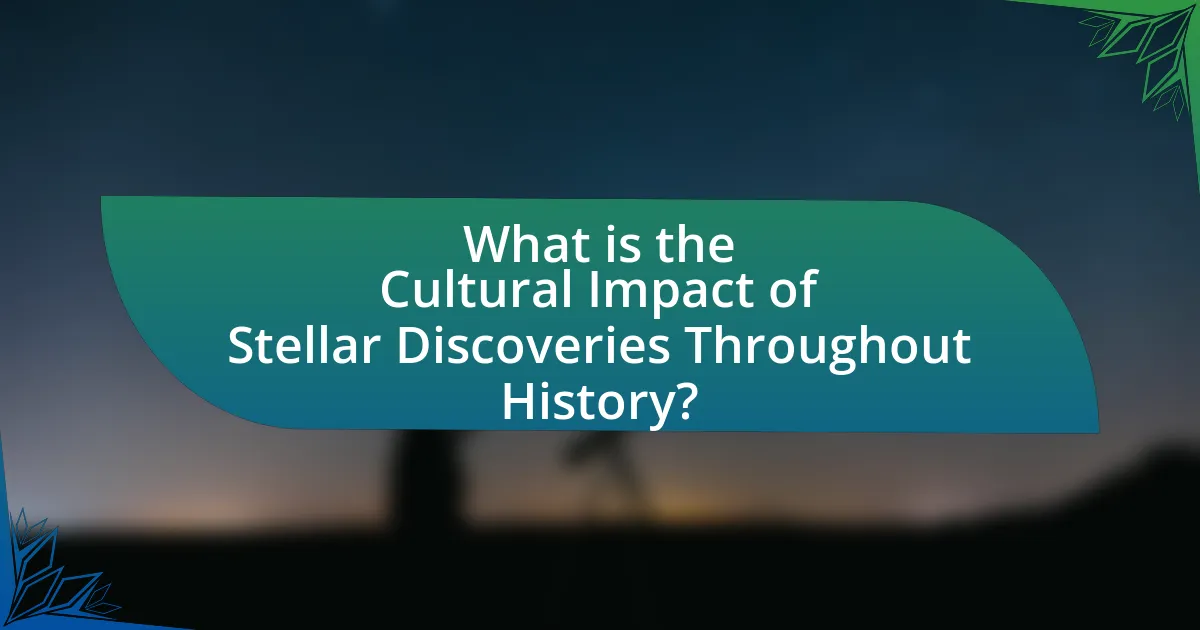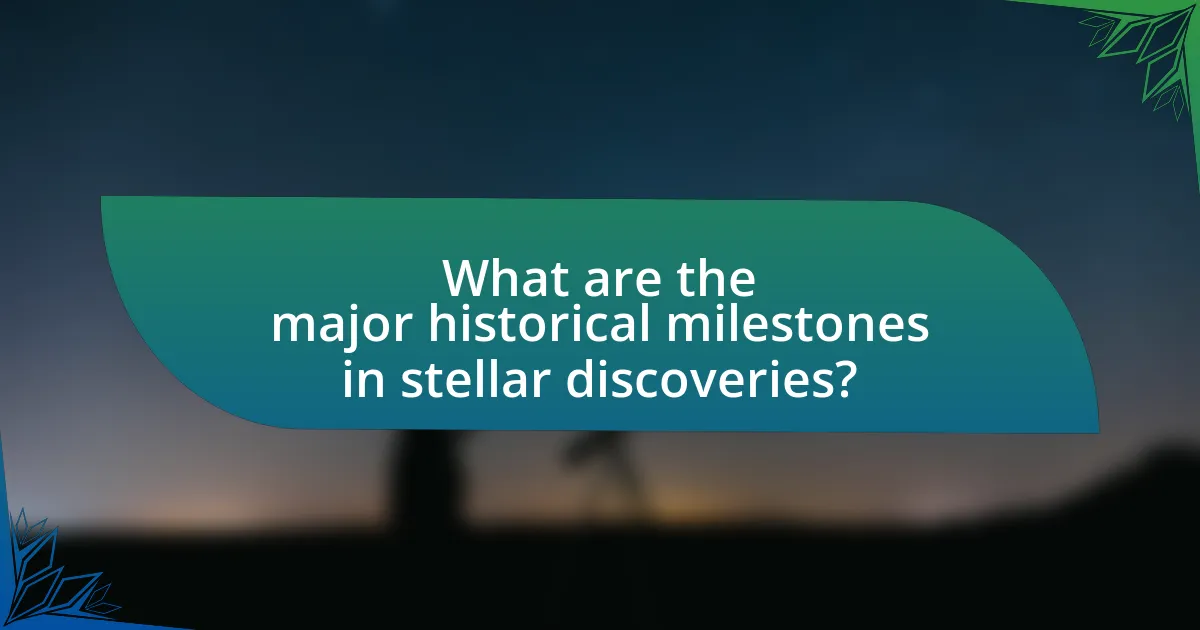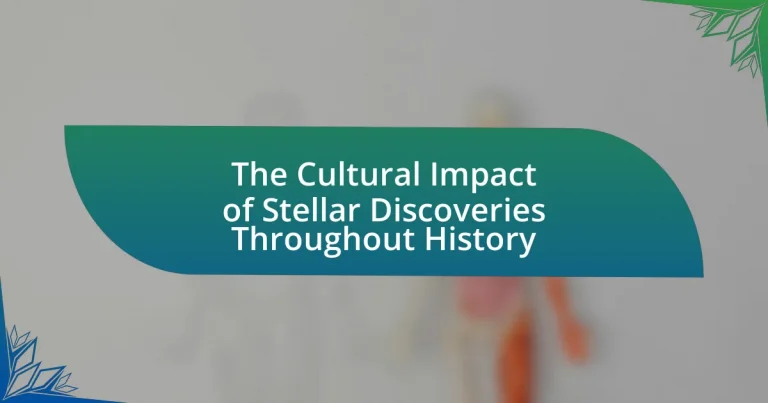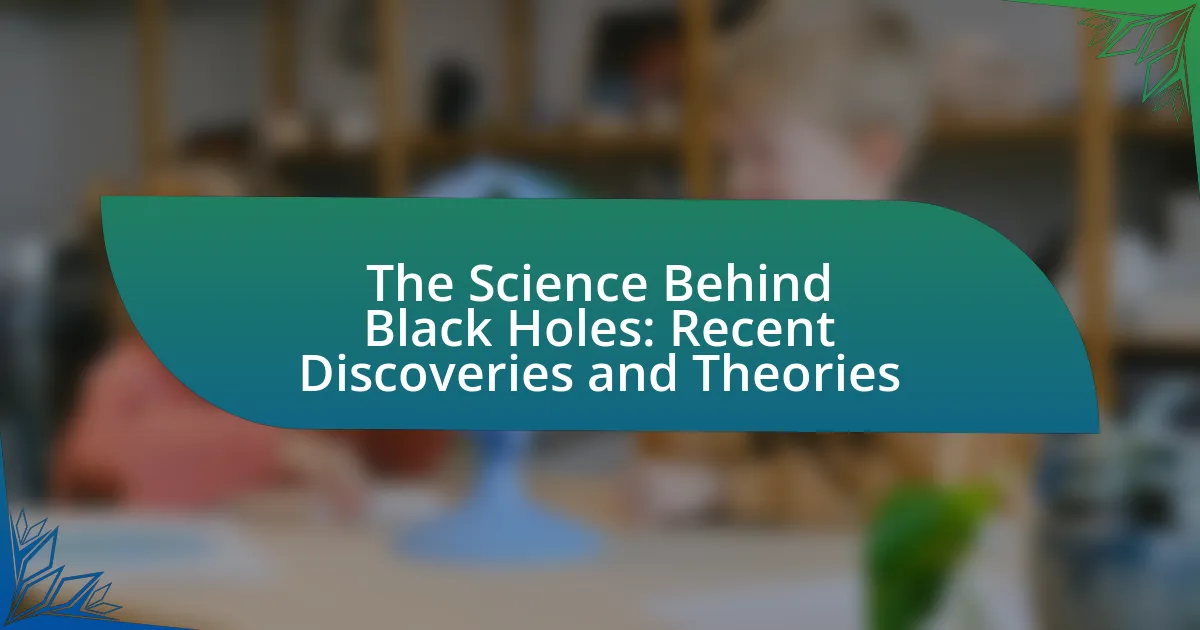The article examines the cultural impact of stellar discoveries throughout history, highlighting how these discoveries have influenced art, religion, philosophy, and scientific thought. Key milestones, such as the heliocentric model by Copernicus and the discovery of exoplanets, are discussed in relation to their effects on societal beliefs and cultural narratives. The article also explores how ancient civilizations interpreted celestial phenomena, the role of astronomy in early societies, and the ongoing influence of modern discoveries on cultural perceptions and public understanding. Overall, it emphasizes the interconnectedness of scientific advancements and cultural evolution in shaping humanity’s understanding of the universe.

What is the Cultural Impact of Stellar Discoveries Throughout History?
The cultural impact of stellar discoveries throughout history has been profound, influencing art, religion, philosophy, and scientific thought. For instance, the heliocentric model proposed by Copernicus in the 16th century challenged the geocentric view upheld by the Church, leading to significant shifts in religious and philosophical perspectives about humanity’s place in the universe. Additionally, the discovery of new celestial bodies, such as Uranus in 1781 by William Herschel, expanded the understanding of the solar system and inspired movements in Romanticism, reflecting humanity’s fascination with the cosmos. Furthermore, the advent of telescopes and later space exploration has not only advanced scientific knowledge but also fostered a sense of global unity and curiosity, as seen in the collective excitement surrounding the Apollo moon landing in 1969. These discoveries have consistently reshaped cultural narratives, prompting societies to reevaluate their beliefs and aspirations in relation to the universe.
How have stellar discoveries influenced human culture?
Stellar discoveries have profoundly influenced human culture by shaping philosophical, scientific, and artistic perspectives. For instance, the heliocentric model proposed by Copernicus in the 16th century challenged the geocentric view, leading to a paradigm shift in understanding humanity’s place in the universe. This shift not only advanced scientific inquiry but also inspired the Enlightenment, which emphasized reason and individualism. Additionally, the discovery of exoplanets has sparked interest in the possibility of extraterrestrial life, influencing literature and media, as seen in works like Carl Sagan’s “Contact.” Furthermore, the observation of cosmic phenomena, such as supernovae and black holes, has inspired countless artistic expressions, from visual arts to music, reflecting humanity’s fascination with the cosmos. These examples illustrate how stellar discoveries have continually reshaped cultural narratives and human thought throughout history.
What are some key stellar discoveries that shaped cultural perspectives?
Key stellar discoveries that shaped cultural perspectives include the heliocentric model proposed by Nicolaus Copernicus, which shifted the understanding of Earth’s place in the universe, leading to the Scientific Revolution. This model, published in “De revolutionibus orbium coelestium” in 1543, challenged the geocentric view held by the Church and influenced philosophical thought regarding humanity’s role in the cosmos.
Another significant discovery is the observation of the moons of Jupiter by Galileo Galilei in 1610, which provided evidence against the geocentric model and supported the heliocentric theory. This finding, documented in “Sidereus Nuncius,” demonstrated that not all celestial bodies orbit the Earth, further altering cultural and scientific perspectives on the universe.
The discovery of the expanding universe by Edwin Hubble in the 1920s, through observations of distant galaxies, fundamentally changed the understanding of the cosmos and humanity’s place within it. Hubble’s work, published in “The Realm of the Nebulae,” led to the realization that the universe is vast and dynamic, influencing philosophical and existential views on life and existence.
These discoveries collectively transformed cultural perspectives by challenging established beliefs, promoting scientific inquiry, and reshaping humanity’s understanding of its place in the universe.
How did ancient civilizations interpret stellar phenomena?
Ancient civilizations interpreted stellar phenomena as significant omens or messages from the divine. For instance, the Babylonians meticulously recorded celestial events and associated them with earthly events, believing that the movements of planets and stars could predict the future. Similarly, the ancient Egyptians aligned their pyramids with specific stars, reflecting their belief in the stars’ influence on life and death. The Greeks, particularly philosophers like Ptolemy, developed complex models to explain celestial movements, viewing them as a reflection of a higher order in the universe. These interpretations were often documented in texts, such as the Babylonian “Enuma Anu Enlil,” which cataloged celestial omens, demonstrating the profound impact of stellar phenomena on their cultures and decision-making processes.
Why is the study of stars significant to cultural development?
The study of stars is significant to cultural development because it has historically influenced navigation, agriculture, mythology, and calendars across various civilizations. For instance, ancient cultures like the Babylonians and Egyptians relied on celestial observations to create calendars that dictated agricultural practices, ensuring food security. Additionally, the Polynesians used star navigation to explore vast oceanic distances, shaping their cultural identity and trade networks. Furthermore, stars have been central to mythological narratives, as seen in Greek and Roman cultures, where constellations were linked to deities and moral lessons, thus enriching cultural storytelling. These examples illustrate how the study of stars has been integral to the advancement and cohesion of societies throughout history.
What role did astronomy play in the development of early societies?
Astronomy played a crucial role in the development of early societies by providing a framework for agricultural planning, navigation, and religious practices. Early civilizations, such as the Mesopotamians and Egyptians, relied on celestial observations to create calendars that dictated planting and harvesting cycles, ensuring food security. For instance, the Egyptians aligned their agricultural calendar with the annual flooding of the Nile, which was predicted by the heliacal rising of the star Sirius. Additionally, astronomy facilitated navigation for trade and exploration, as seen in the Polynesian wayfinding techniques that utilized stars for oceanic travel. Furthermore, celestial events were often integrated into religious beliefs, influencing rituals and societal structures, as evidenced by the Mayan civilization’s intricate astronomical calendar that governed their religious ceremonies.
How have stellar discoveries inspired art and literature?
Stellar discoveries have profoundly inspired art and literature by providing themes of wonder, exploration, and existential reflection. For instance, the discovery of new celestial bodies and phenomena, such as the rings of Saturn by Galileo in 1610, has influenced artists like Vincent van Gogh, whose painting “Starry Night” captures the emotional resonance of the night sky. Additionally, literature has been shaped by astronomical advancements; works like “Cosmos” by Carl Sagan explore the universe’s mysteries, blending scientific inquiry with poetic expression. These examples illustrate how the awe of the cosmos has driven creative expression across various artistic mediums, reflecting humanity’s quest for understanding and connection to the universe.

What are the major historical milestones in stellar discoveries?
The major historical milestones in stellar discoveries include the invention of the telescope in the early 17th century, which allowed astronomers like Galileo Galilei to observe celestial bodies in detail, leading to the discovery of Jupiter’s moons. In 1781, William Herschel discovered Uranus, expanding the known boundaries of the solar system. The development of spectroscopy in the 19th century enabled scientists like Gustav Kirchhoff and Robert Bunsen to analyze starlight, revealing the chemical composition of stars. The 20th century saw the discovery of cosmic microwave background radiation by Arno Penzias and Robert Wilson in 1965, providing evidence for the Big Bang theory. Additionally, the launch of the Hubble Space Telescope in 1990 revolutionized our understanding of the universe by capturing high-resolution images of distant galaxies and nebulae. Each of these milestones significantly advanced our knowledge of stellar phenomena and the universe’s structure.
Which discoveries marked turning points in our understanding of the universe?
Key discoveries that marked turning points in our understanding of the universe include the heliocentric model proposed by Nicolaus Copernicus, the laws of planetary motion formulated by Johannes Kepler, and the theory of general relativity introduced by Albert Einstein. Copernicus’s model, published in 1543, shifted the perspective from an Earth-centered universe to one where the Earth orbits the Sun, fundamentally altering astronomical thought. Kepler’s laws, established in the early 17th century, provided a mathematical framework for planetary motion, demonstrating that orbits are elliptical rather than circular. Einstein’s general relativity, published in 1915, revolutionized the understanding of gravity, describing it as the curvature of spacetime caused by mass, which has been confirmed through various experiments and observations, such as the bending of light around massive objects. These discoveries collectively transformed the scientific community’s comprehension of the cosmos and humanity’s place within it.
How did the invention of the telescope change our view of the stars?
The invention of the telescope fundamentally transformed our view of the stars by enabling astronomers to observe celestial bodies in unprecedented detail. This advancement allowed for the discovery of previously unseen phenomena, such as the moons of Jupiter, the phases of Venus, and the intricate structure of Saturn’s rings, as first documented by Galileo Galilei in the early 17th century. These observations challenged the geocentric model of the universe, leading to the acceptance of the heliocentric model proposed by Copernicus, which positioned the Sun at the center of our solar system. The telescope’s ability to reveal the vastness and complexity of the universe expanded human understanding of our place in it, fostering a shift in cultural and scientific perspectives that emphasized observation and empirical evidence over traditional beliefs.
What impact did the discovery of exoplanets have on cultural narratives?
The discovery of exoplanets has significantly influenced cultural narratives by expanding humanity’s understanding of the universe and our place within it. This shift has inspired a resurgence in science fiction literature and media, reflecting themes of exploration, diversity of life, and the potential for human colonization of other worlds. For instance, the Kepler Space Telescope’s findings, which confirmed thousands of exoplanets, have led to increased public interest in astrobiology and the search for extraterrestrial life, as seen in popular films and television series like “The Expanse” and “Interstellar.” Furthermore, these discoveries challenge traditional philosophical and religious views about humanity’s uniqueness, prompting discussions about existence and the nature of life beyond Earth.
How have different cultures responded to stellar discoveries over time?
Different cultures have responded to stellar discoveries through a blend of reverence, scientific inquiry, and mythological interpretation. For instance, ancient civilizations like the Babylonians meticulously recorded celestial events, leading to the development of early astronomy and calendars. In contrast, the Greeks integrated stellar observations into their philosophical frameworks, with figures like Ptolemy proposing geocentric models that influenced Western thought for centuries.
During the Renaissance, the heliocentric model proposed by Copernicus sparked significant debate and ultimately transformed scientific understanding, challenging the Church’s authority. In Eastern cultures, such as in China, astronomical observations were often linked to agricultural practices and state governance, reflecting a pragmatic approach to celestial phenomena.
The discovery of new celestial bodies, such as Uranus in 1781, was met with excitement and further exploration, leading to advancements in telescopic technology and a deeper understanding of the universe. Overall, these varied responses illustrate how stellar discoveries have shaped cultural narratives, scientific progress, and philosophical thought across different societies throughout history.
What are some examples of cultural adaptations to new astronomical knowledge?
Cultural adaptations to new astronomical knowledge include the incorporation of celestial events into calendars, the development of navigation techniques, and the influence on religious beliefs. For instance, ancient civilizations like the Maya created complex calendars based on astronomical observations, which guided agricultural practices and religious ceremonies. Additionally, the Polynesians utilized stellar navigation to explore vast oceanic distances, demonstrating a direct application of astronomical knowledge in their cultural practices. Furthermore, the heliocentric model proposed by Copernicus led to significant shifts in religious thought, challenging the geocentric view held by the Church and prompting a reevaluation of humanity’s place in the universe. These examples illustrate how advancements in astronomical understanding have profoundly shaped cultural practices and beliefs throughout history.
How have religious beliefs been influenced by stellar discoveries?
Religious beliefs have been significantly influenced by stellar discoveries, particularly through the challenges they pose to traditional cosmologies. For instance, the heliocentric model proposed by Copernicus in the 16th century contradicted the geocentric view endorsed by the Church, leading to a reevaluation of humanity’s place in the universe. This shift prompted theological debates, as seen in the trial of Galileo, who supported heliocentrism, which ultimately resulted in a conflict between science and religious doctrine. Furthermore, discoveries such as the vastness of the universe and the existence of exoplanets have led some religious thinkers to reconsider the nature of creation and the possibility of life beyond Earth, influencing contemporary theological perspectives.

How do modern stellar discoveries continue to shape culture today?
Modern stellar discoveries shape culture today by influencing scientific understanding, inspiring art, and driving technological advancements. For instance, the discovery of exoplanets has expanded our perception of the universe, leading to a surge in interest in astrobiology and the search for extraterrestrial life. This has been reflected in popular media, such as films and literature, which explore themes of life beyond Earth, thereby enriching cultural narratives. Additionally, advancements in telescope technology, such as the James Webb Space Telescope, have provided unprecedented images and data about the cosmos, fostering public engagement with science and encouraging educational initiatives. These discoveries not only enhance our knowledge but also inspire a sense of wonder and curiosity, which are fundamental aspects of human culture.
What are the current trends in stellar research and their cultural implications?
Current trends in stellar research include the study of exoplanets, the investigation of stellar evolution, and advancements in gravitational wave astronomy. These trends have significant cultural implications, as the discovery of potentially habitable exoplanets challenges traditional views of humanity’s uniqueness and prompts philosophical discussions about life beyond Earth. For instance, the Kepler Space Telescope has identified thousands of exoplanets, leading to increased public interest in astrobiology and the potential for extraterrestrial life. Additionally, research into stellar evolution enhances our understanding of the universe’s lifecycle, influencing cultural narratives about our place in the cosmos. Gravitational wave astronomy, highlighted by the detection of waves from colliding black holes, has revolutionized our understanding of the universe and sparked discussions about the nature of reality and existence. These developments collectively reshape societal perspectives on science, spirituality, and humanity’s future in the universe.
How is the search for extraterrestrial life affecting cultural perceptions?
The search for extraterrestrial life is significantly reshaping cultural perceptions by fostering a sense of curiosity and openness towards the universe. This quest has led to increased public interest in science, as evidenced by the rise in popularity of documentaries, books, and media focused on space exploration and the possibility of alien life. For instance, NASA’s Mars missions and the discovery of exoplanets have sparked discussions about humanity’s place in the cosmos, encouraging a more inclusive worldview that embraces the potential for life beyond Earth. Additionally, cultural narratives in films and literature often reflect these themes, illustrating how the search for extraterrestrial life influences societal beliefs and values.
What role does popular media play in shaping public understanding of stellar discoveries?
Popular media significantly influences public understanding of stellar discoveries by disseminating complex scientific information in accessible formats. Through documentaries, news articles, and social media, popular media simplifies intricate concepts, making them relatable and engaging for a broader audience. For instance, the portrayal of the discovery of exoplanets in films and television has sparked public interest and curiosity, leading to increased engagement with astronomy. Research indicates that media coverage can enhance public knowledge and interest in science, as seen in the aftermath of significant astronomical events like the 2017 solar eclipse, which was widely covered and resulted in a surge of public interest in celestial phenomena.
What practical insights can we gain from the cultural impact of stellar discoveries?
The cultural impact of stellar discoveries provides practical insights into humanity’s evolving understanding of the universe and its influence on societal values. For instance, the discovery of the heliocentric model by Copernicus shifted perspectives from Earth-centric views to a broader cosmic understanding, fostering scientific inquiry and challenging religious doctrines. This shift not only advanced astronomy but also encouraged critical thinking and skepticism, which are foundational to modern scientific methods. Furthermore, the 20th-century discovery of cosmic microwave background radiation, which provided evidence for the Big Bang theory, has influenced philosophical discussions about existence and the nature of reality, prompting cultural movements that embrace scientific literacy and exploration. These examples illustrate how stellar discoveries can reshape cultural narratives, inspire innovation, and promote a collective curiosity about our place in the universe.
How can we use historical perspectives on stellar discoveries to inform future explorations?
Historical perspectives on stellar discoveries can inform future explorations by providing insights into the methodologies, technologies, and cultural contexts that shaped past astronomical advancements. For instance, the use of telescopes in the 17th century, as pioneered by Galileo, revolutionized our understanding of celestial bodies and demonstrated the importance of observational data in astronomy. This historical context emphasizes the need for robust observational techniques in current and future explorations, such as the deployment of advanced space telescopes like the James Webb Space Telescope, which builds on centuries of astronomical knowledge. Additionally, understanding the societal impacts of discoveries, such as the Copernican revolution, can guide how we communicate scientific findings to the public, ensuring that future explorations are not only scientifically rigorous but also culturally relevant and engaging.
What lessons can be learned from the cultural responses to past stellar discoveries?
Cultural responses to past stellar discoveries reveal the profound impact of scientific advancements on societal beliefs and values. For instance, the heliocentric model proposed by Copernicus challenged the geocentric view upheld by the Church, leading to significant shifts in religious and philosophical thought during the Renaissance. This illustrates how scientific discoveries can provoke resistance and re-evaluation of established norms. Additionally, the discovery of exoplanets has sparked renewed interest in the possibility of extraterrestrial life, influencing popular culture and inspiring movements toward space exploration. Such responses highlight the interplay between scientific knowledge and cultural evolution, emphasizing the need for open dialogue between science and society to foster understanding and acceptance of new ideas.




